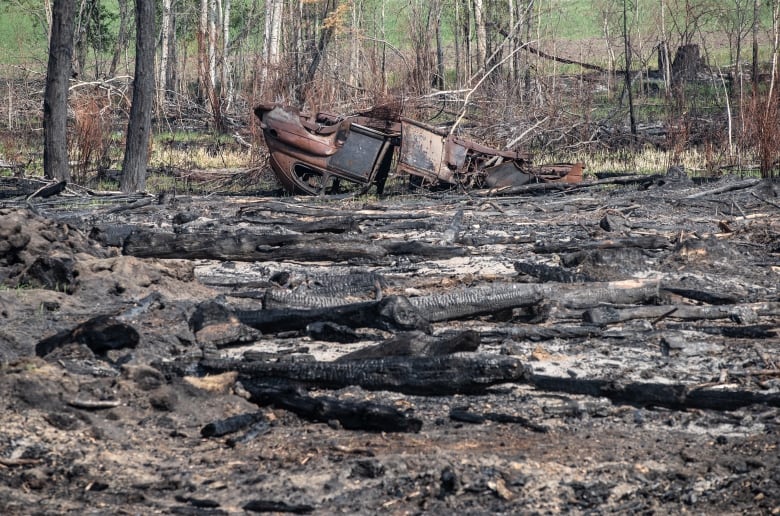Andrew Buchanan, a firefighter based in Strathcona County, says he can’t talk long. Wildfires are moving quickly, and there’s no guarantee an alarm won’t sound while he’s on the line, drawing him back on the job.
It’s been a challenging wildfire season, said Buchanan, who is also the lead training officer for the Emergency Services Academy (ESA), which provides professional firefighting training.
The size of the fires are large, and when paired with a lack of moisture, the amount of dry fuel, the weather and the wind, conditions aren’t working in the favour of firefighters, he said.
“We definitely need more firefighters, for sure. I mean, if you look at these large-scale incidences, it seems that we’re always having to call in military, we’re having to call in overseas,” Buchanan said. “I don’t think that’s going to be a sustainable thing, going into the future.”
Alberta has been gripped for several weeks in the midst of a devastating wildfire season. Canadian Armed Forces reservists joined the front lines last month.
Across the country, challenges have emerged. More than 2.7 million hectares of forest went up in flames last month across Canada, including in B.C., Ontario and Manitoba, Emergency Preparedness Minister Bill Blair said last week.
Still, the minister said Ottawa isn’t yet running short of firefighting resources, though in response to a reporter’s question did say the wildfires could end up testing the limits.
“I don’t want to refer to this as a competition, but we have many fires in many parts of the country drawing upon a limited number of resources, both within Canada and internationally,” Blair said.
Natural Resources Minister Jonathan Wilkinson previously said the country will participate in an international pilot project to train firefighters from towns and cities to respond to fires that threaten homes and businesses. Canada has provided $170 million to develop the WildFireSat system, scheduled to launch by 2029, which uses a “purpose-built public satellite system” to monitor wildfires.
When the unprecedented becomes precedent
During challenging wildfire seasons, Alberta can access additional firefighting resources from other jurisdictions by utilizing resource sharing agreements, many of which are allocated through the Canadian Interagency Forest Fire Centre (CIFFC).
This year, the province welcomed 1,836 firefighters from British Columbia, New Brunswick, Newfoundland, Ontario, Quebec, Prince Edward Island, Yukon, the United States, Australia and New Zealand. An additional 215 firefighters from South Africa were scheduled to arrive this weekend.
“In extreme circumstances, some resources deployed through [CIFFC] may be cancelled, diverted or demobilized early,” wrote Derrick Forsythe, a spokesperson with Alberta Wildfire.
“However, Alberta has independent resource sharing agreements in place such as the Northwest Compact and an agreement with Jalisco, Mexico, that can be used to request additional help when needed.”
Jen Beverly, a former firefighter and now a University of Alberta assistant professor of wildland fire research, said there’s been good, documented evidence of increasing trends of longer fire seasons and larger fires, as well as increased frequency of extended dry spells.
“It’s no longer the case where we can look at past data and then understand what to expect this year or the next year. In fact, that word ‘unprecedented’ is what I’m hearing most often around the fire season — unprecedented fire behaviour,” said Beverly, who works in the U of A’s department of renewable resources.
“I’ve been hearing that so frequently in the last 10 years. It’s like the precedent is unprecedented. We should be expecting unprecedented conditions.”
Radio Active8:04Wildfire mapping
A new tool from University of Alberta researchers could help more communities understand how vulnerable they are to wildfires. Jen Beverly is an assistant professor of wildland fire at the U of A.
That means that officials can’t rely on their past experiences or data when it comes to wildfires, Beverly said, and everyone must approach the challenge in a different way.
“It’s shifting from what has been, I think, a focus on trying to predict and accepting that we can’t do that very well,” Beverly said, adding a potential area of focus could include assessing and mapping fuel hazards.
For Buchanan, the Strathcona County firefighter, the situation across the province has led to increasing interest in more people turning to the ESA to receive firefighting training. But the situation calls for more action now, he said.
“The more local boots on the ground we can get trained here means we’ll be much more effective in the long run,” he said.
“If these are the sort of spring seasons that we’re going to see — dry, heavy fuel loads, increased wildfire risks — we’re going to need to have those trained first responders ready to go, rather than having to rely on international support.
“That’s incredible, people coming in. But I just don’t think that’s a system that’s going to work, long-term.”
The CIFFC lists five levels of preparedness, which refer to the wildland fire situation and the availability of firefighting resources in Canada. Level 1 is the lowest risk and Level 5 the highest. As of Friday, Alberta was listed as Level 5.

